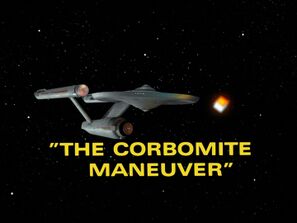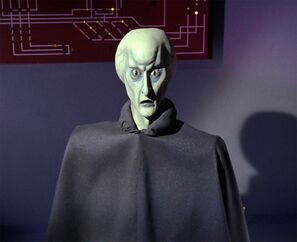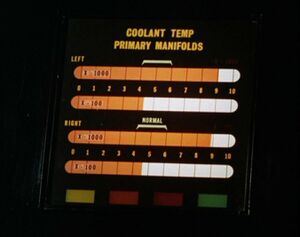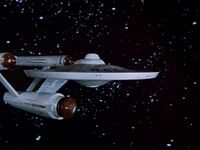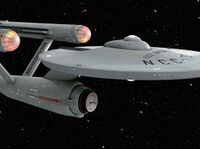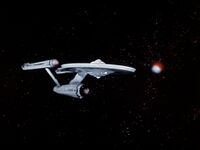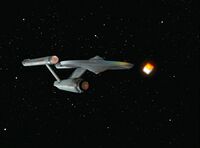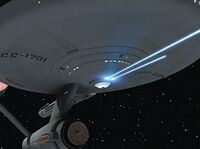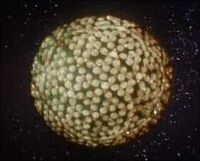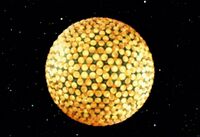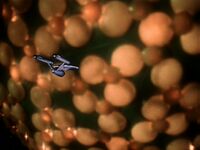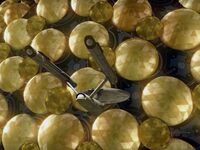The Corbomite Maneuver (episode)/background information
| “The Corbomite Maneuver” | |||||
|---|---|---|---|---|---|
| Star Trek: The Original Series Episode | |||||
| In-Universe Details | |||||
| Stardate | 1512.2 | ||||
| Date | 11 May 2266 (Terran) | ||||
| Locations | USS Enterprise
Fesarius | ||||
| Quadrant | Alpha | ||||
| Background Information | |||||
| Production | |||||
| Written by | Jerry Sohl | ||||
| Directed by | Joseph Sargent | ||||
| Produced by | Gene Roddenberry John D. F. Black (AP) Robert H. Justman (AP) | ||||
| Episode | TOS: 1x2 | ||||
| Production No. | 6149-03 | ||||
| Date aired | 13 October 1966 | ||||
| Chronology | |||||
| |||||
| |||||
| |||||
| Main Article | |||||
"The Corbomite Maneuver" is the tenth episode of the first season of the American science fiction television series, Star Trek. Written by Jerry Sohl and directed by Joseph Sargent, it first aired on November 10, 1966.
The USS Enterprise encounters a massive and powerful alien starship and its unusual pilot.
The episode features a young Clint Howard, brother of actor-turned-director Ron Howard, who plays the alien at the end (with an overdubbed, ethereal voice provided by Walker Edmiston).[1] This was the first regular episode produced after the two pilots and the first episode filmed in which DeForest Kelley played Dr. Leonard McCoy, Nichelle Nichols played Lt. Uhura and Grace Lee Whitney played Yeoman Rand.[2] (Because they were not aired in production order audiences saw them for the first time in "The Man Trap").
Production timeline[edit | edit source]
- Story outline "Danger Zone" by Jerry Sohl: late-March 1966
- Revised outline "The Corbomite Maneuver" by Sohl: 4 April 1966
- Revised outline by Gene Roddenberry: 17 April 1966
- First draft teleplay by Sohl: 21 April 1966
- Revised first draft teleplay: 29 April 1966
- Additional revision by Sohl: 3 May 1966
- Final draft teleplay by Roddenberry: 9 May 1966
- Revised final draft teleplay: 12 May 1966
- Second revised final draft teleplay: 20 May 1966
- Additional revisions: 23 May 1966, 25 May 1966
- Cast and crew rehearsal: 23 May 1966
- Filmed: 24 May 1966 – 2 June 1966
- Day 1 – 24 May 1966, Tuesday – Desilu Stage 9: Int. Sickbay, Kirk's quarters, Bridge
- Day 2 – 25 May 1966, Wednesday – Desilu Stage 9: Int. Bridge
- Day 3 – 26 May 1966, Thursday – Desilu Stage 9: Int. Bridge
- Day 4 – 27 May 1966, Friday – Desilu Stage 9: Int. Bridge
- Day 5 – 31 May 1966, Tuesday – Desilu Stage 9: Int. Bridge & Makeup test for Clint Howard
- Day 6 – 1 June 1966, Wednesday – Desilu Stage 9: Int. Bridge, Briefing room, Balok's pilot vessel (redress of briefing room)
- Day 7 – 2 June 1966, Thursday (Half Day) – Desilu Stage 9: Int. Corridors, Turbolift, Transporter room
- Original airdate: 10 November 1966
- Rerun airdate: 11 May 1967
- First UK airdate: 18 October 1969
Even the final draft of this script, dated 3 May 1966, was quite different from the aired version:
- The character of Uhura was not present. Dave Bailey was the communications officer, and he did not "flip out" as he does in the aired episode.
- Lieutenant Ken Easton was the navigator.
- Many bits of character-building were also absent. There were no flypaper, chess or poker analogies – Kirk simply decided to bluff Balok out of the blue.
- The planet where Balok intended to imprison the Enterprise crew was named Carpi.
- There was also no reference in this draft to:
- Kirk's salad
- Curiosity on Spock's part as to what Balok looks like – instead, Balok initiated visual contact with the Enterprise
- Spock's opinion that Balok reminded him of his father or Scott's retort
Story and script[edit | edit source]
- A line from Balok warning the crew they had one minute left was not recorded, leaving Sulu to comment, "I knew he would" in response to nothing.[3] The preview has an unused cut of Balok saying, "We grant you one minute" that could be modified and dubbed into the episode.
- Spock confesses an ignorance of poker, and he probably wouldn't enjoy the game since he said in Season two episode “The Doomsday Machine” that Vulcans do not bluff.
- Part of engineering's location is referred to in this episode. Kirk orders Bailey to coordinate drills with engineering, and Bailey says on two distinct occasions "On the double, Deck 5, give me the green light!" and also "Engineering Deck 5, report! Come on phaser crews, let's get with it!". He could either be referring to an engine room in the saucer on deck 5 or a separate "engineering deck 5" that exists in lower levels (where some of engineering is referenced to be in episodes like “The Enemy Within”, “The Conscience of the King”, and “Day of the Dove”)
- This is one of the few episodes of the original which places a time stamp on the events. It is placed two centuries after mankind's early space explorations, or roughly the late 22nd century. Also, in Star Trek: The Motion Picture, the V'ger probe is said to be roughly two-hundred years old, placing the film in the same era. It would later be established in Star Trek II: The Wrath of Khan and Star Trek IV: The Voyage Home that these adventures took place in the late 23rd century. Also, in the Star Trek Chronology by Michael Okuda, Okuda states that Gene Roddenberry made a request for a Star Trek timeline while producing The Next Generation, unaware Okuda was already working on such a time line. This chronology was used to firmly establish the calendar date of TNG (2364) and ALL Star Trek dates, including The Original Series, were established using this date. Therefore, it was retroactively established that the original series took place three hundred years after its broadcast date, placing this episode in 2266. Obviously, when the Original Series was being filmed the exact time line had yet to be established, but one way to reconcile the dialogue "mistake" is to assume that Kirk was referring not to the Moon landing, but to Zefram Cochrane's warp flight of 2063 – which would put this episode 203 years after that event.) It is also possible that this statement was only part of the bluff.
- When addressing the Fesarius, Kirk identifies his ship as the United Earth Ship Enterprise, nomenclature which was never used again. (It may have been this episode which led to the later idea to refer to a "Federation" as the parent organization of Starfleet; the Enterprise is not referred to as such in this episode, and the First Federation never appears onscreen hereafter.)
- Balok displays a knowledge of Earth popular culture. When discussing the "false" Balok, he referred to it as "the Mr. Hyde to my Jekyll". However, the methods that Balok employed in this episode actually bore much more similarity to The Wizard of Oz.
- The dimensions (107 meters on a side) and mass (11,000 metric tons) of the cube imply an average density of 9 kg per cubic meter, only 7 times that of earth air at sea level. No known solid materials are that light, although aerogels (which are mostly air) are lighter.
Effects[edit | edit source]
- This episode was originally scheduled to air much earlier than it did, but the large amount of visual effects took several months to complete. The producers had to delay the planned airdate twice, before eventually broadcasting "The Corbomite Maneuver" as the tenth episode of the season. [4]
- In the original version of the series, this was the first episode in which the forward sections of the warp engine nacelles were made to glow, though in the teaser this didn't happen because it seems to have used footage from “The Cage”. In the remastered TOS, however, this is no longer true, as the nacelles of the ship are uniformly shown to glow.
- The distinctive bridge sound effects of TOS are first heard in this episode. Early episodes of The Twilight Zone (notably "Execution" from 1960), previously featured this distinctive computer sound.
- The set of Balok's room was a re-dress of the Enterprise conference room set.[5] It was later recycled to create the bar in “Court Martial” (later reused in “The Trouble with Tribbles”).[3]
- Both in terms of its order on the production schedule, and its order of televised broadcast, this episode marks the very first time that the Enterprise fires its phasers. The actual burst that the ship fires at the warning buoy is unique to this episode.
- The shot of the ship being towed by the small First Federation pilot vessel, from a perspective behind the nacelles, was re-used countless times in future episodes, with different ships or planets matted in. When it was used later, it was often slowed down, which made it much more grainy than the clear print in this episode. Around halfway in the second season this shot was replaced by a much better-looking new shot of the ship.
- Although we never learn the specific dimensions of the Enterprise during the series, it is established visually to be bigger than the cube, which Sulu says is 107 meters on each side.
Costumes[edit | edit source]
- This episode contains a number of "firsts" for the costume department. Although some of the pilots' uniforms were seen on background extras, this is the first episode in which black collars on tunics debut. Nevertheless, some of the uniforms – particularly Spock's – have higher, loose, "turtleneck" black collars than generally appeared throughout the series. In Sulu's first close-up, the zipper built into the collar is clearly visible – because he was wearing a "leftover" from the first two pilots that was retrofitted, [citation needed] not quite expertly, with the new black collar.
- Additionally, "The Corbomite Maneuver" saw the initial appearance of skirt uniforms, as well as "plunging neckline" collars for most women. Red operations division tunics were also seen for the first time here, as was the silk, short-sleeved "laboratory" tunic for the CMO. The system of sleeve rank insignia was also more refined in this episode than it had been in either pilot. Noticeably, Kirk first wore the insignia he would display throughout the series, and the rank stripes themselves took on a more wavy, stylized design than the simple bands they had been in the previous pilots, complete with broken bits of braid to denote the ranks of lieutenant jg, lieutenant commander, and captain.
- Finally, beginning with this episode, the men's uniforms featured a "raglan" construction, like that found in crew-neck sweaters, with the tops of the sleeves reaching all the way up to the collar. In the two previous pilots, the uniform sleeves were constructed like those in men's dress shirts, with their tops ending at the upper arm.
- Despite the introduction of the red operations division tunic in this episode, Uhura is seen in a gold command division uniform both here and in “Mudd's Women”. She also incongruously wears a sciences division assignment patch, rather than the appropriate command "star".
- In addition, in the bridge scene following the destruction of Balok's cube, several crew members who are repairing the damage can be seen wearing blue uniforms without black collars that were left over from the pilots.
- When Kirk leaves sickbay, he throws his uniform shirt over his shoulders; the tunic has only two solid gold rank stripes. In the turbolift and changing in his quarters, his tunic has the 2½ stripe marking.
- When McCoy enters the bridge right after Balok announced the impending destruction of the Enterprise, he is wearing a standard sciences division uniform. Shortly afterward, there are several close-ups on Spock at the library computer station with McCoy in the foreground, now wearing the short-sleeved tunic. But he had never left the bridge or had any opportunity to change his clothing during that time. When Bailey at navigation begins his tirade, McCoy enters from left and is back in his standard uniform, in which he remains for the rest of the episode.
Sets and props[edit | edit source]
- There are detailed close-ups of some of the engineering station read-outs in this episode.
- There are signs of this being an early production, such as a bridge chair squeaking rather loudly near the end of the episode (when Uhura is listening in on Balok's distress call), as well as hearing the ship doors, made of wood, slide on the stage floor as they open and close. Stage noises were edited out of later episodes.
- Instead of reusing the bridge helm station as in the two pilot episodes, a dedicated transporter console makes its debut. The top was painted black and the intercom stands alone on the top of the console. Beginning with “Mudd's Women”, the next episode to be filmed, the console was painted its customary reddish-orange seen in all subsequent episodes and the intercom was bracketed by two alert lights.
- The panel seen behind Balok when Kirk, McCoy and Bailey first beam aboard the pilot ship was later used as the main panel in the Enterprise engineering room.
- The interior of Balok's ship was a redress of the briefing room set, as can be seen on production photos.[5] Several set pieces from it were reused in the starbase bar in “Court Martial”.
- When Kirk reports to the bridge from the turbolift, a rare camera angle from the elevator illustrates the panel to the right of the main viewscreen, and the two bridge consoles to the left of the science station. These sections were usually rolled out (off-screen) to facilitate filming the navigation console and Spock's station. Like “Where No Man Has Gone Before”, the turbolift has double doors (the inner is gray; the outer is red), like modern elevators. This feature was later eliminated, probably because it was too cumbersome to maintain.
- The "screen-saver" animation on the main bridge viewscreen from “Where No Man Has Gone Before” is just barely visible over Bailey's shoulder during the repair scene after the battle with the cube buoy.
- The colors of the cube buoy reflect on the railings at the front of the bridge. When this perspective was later re-used as the stock view screen shot for the next three seasons, the reflecting lights still showed up on the railings. (A new stock shot of the viewscreen was made in the middle of the second season.)
Production[edit | edit source]
- Also filmed for this episode (by associate producer Robert H. Justman) was George Takei's reaction shot in which he turned around and looked at Kirk, reused in dozens of future episodes whenever something strange appeared on the viewscreen. A similar clip was filmed of Walter Koenig during season two.[5]
- This was the first regular episode of Star Trek: The Original Series produced following the two pilots.
- It was also the first episode to feature Kirk's famous "Space: the final frontier" monologue in the opening credits.
- A front-on close-up of Balok, without the rippling distortion of his image as seen on the main viewing screen, was the final shot of past episodes that was displayed in many of the series' end credits. In Inside Star Trek: The Real Story, Robert Justman explained that he superimposed the credit "Executive in Charge of Production Herbert F. Solow" over Balok's image as an in-joke. Justman later secured a screen grab of the shot and kept it in his home office, in what he called the "cheapest, junkiest black frame" he could find. (pp. 194-195)
- Although the script instructed Spock actor Leonard Nimoy to emote a fearful reaction upon his first sight of the Balok puppet, director Joseph Sargent suggested to Nimoy that he ignore what the script called for and instead simply react with the single word "Fascinating." The suggestion of this response helped refine the Spock character.[6]
- This is the first episode to use the "cello" theme arranged by Fred Steiner. The DVD and Blu-Ray prints incorrectly used the original theme recorded for “The Man Trap”.[4]
Continuity[edit | edit source]
- Yeoman Rand brings hot coffee to the bridge, despite power being out in the galley, prompting McCoy to ask her how she did it. "I used a hand phaser and zap – hot coffee," was her reply, which suggests that there may be a weapons locker in the kitchen; this would later prove an important plot point in Star Trek VI: The Undiscovered Country.
- Part of Kirk's dialogue "there's no such thing as the unknown, only things temporarily hidden" is also said by Kirk in the alternate reality. (Star Trek Beyond)
Preview[edit | edit source]
- The preview contains a Captain's Log recorded solely for the preview: "Captain's log, stardate 1512.2. The Enterprise and crew are held captive by a strange, alien vessel."
- Balok's dialogue as the puppet was rerecorded to replace "We therefore grant you 10 Earth time periods known as minutes" from the finished episode with the simpler and more stressful "We grant you one minute."
Reception[edit | edit source]
- This episode was nominated for a Hugo Award in 1967 as "Best Dramatic Presentation".
- In the 1970s, the Mego toy company used Balok's "puppet head" to create "The Keeper" action figure doll (despite Balok not being Talosian).
- At the Rally to Restore Sanity and/or Fear on October 30, 2010, Jon Stewart and Stephen Colbert referred to this episode by name after riffing on the dangers of "corbomite" in bottled water; they also mentioned Uhura's incongruous uniform, as described above.[7]
Remastered information[edit | edit source]
- The remastered version of this episode premiered in syndication the weekend of 9 December 2006. New shots of the Enterprise, the pilot vessel, the Fesarius and the warning cube were rendered. As a "tip of the hat" to the original episode, the opening shot of the Enterprise for the remastered version was the same as seen on the view screen in the remastered version of “The Menagerie, Part I” and “The Menagerie, Part II” (except the CGI model was modified to match the rest of the episode, with the smaller antenna dish, the spinning nacelle domes and the lack of spires on them).
In the original version of this episode, when Sulu announces there is one minute left on the timer, the timer actually reads: "2:02… 2:01… 1:00 (the two-minute marker changes to one as the one-second marker changes to zero) … 1:59". In the remastered version, this apparent error is corrected by the insertion of an entirely redesigned chronometer.

- The next remastered episode to air was “Friday's Child”.
Video and DVD releases[edit | edit source]
- Original US Betamax/VHS release: 28 February 1985
- Original UK VHS release (two-episode tapes, CIC Video): Volume 2, catalog number VHR 2210, release date unknown
- As part of the UK Star Trek - The Three Beginnings VHS collection: 31 January 1994
- US VHS release: 15 April 1994
- As part of the UK Star Trek - The Four Beginnings VHS collection: release date unknown
- UK re-release (three-episode tapes, CIC Video): Volume 1.1, 24 June 1996
- Original US DVD release (single-disc): Volume 1, 17 August 1999
- As part of the TOS Season 1 DVD collection
- As part of the TOS Season 1 HD DVD collection
- As part of the TOS Season 1 Blu-ray collection
Cast[edit | edit source]
- Leonard McCoy, Janice Rand, and Uhura debut here.
- Sulu has transferred to the command division from the sciences division following his premiere in “Where No Man Has Gone Before”. This the first episode in which he occupies his familiar seat at the helm. The change was made because the producers realized there's no need for an astrophysicist in every episode, yet they had to have someone sitting at the helm.[5]
- Michael Dunn (popular at the time for his role as Dr. Loveless in The Wild Wild West) was an early choice for the part of Balok; however, Gene Roddenberry thought something "much more weird" would be more effective, leading to six-year-old Clint Howard being cast. Dunn later appeared as Alexander in “Plato's Stepchildren”.[4]
- Makeup artist Fred Phillips originally wanted to shave Clint Howard's head; however, the boy and his father denied his request and Howard wore a bald cap in his appearance as Balok.[4]
- Both Stewart Moss and Bruce Mars were considered for the role of Dave Bailey before Anthony Call was eventually cast.[4] Some sources list both actors as appearing in background roles in the episode; however, they seem to be cut from the final print.
- The "tranya" served by Balok was actually grapefruit juice. Clint Howard, who was a little kid at the time, had to pretend very hard to like the drink, which he found distasteful. (TOS Season 1 DVD special features)
- James Doohan's wartime injury to his right hand is briefly visible in the conference room scene when he passes a coffee thermos. Generally this was carefully hidden off-camera, but it can also be seen when he's holding a phaser in “Catspaw”, as he carries a large bundle of tribbles in “The Trouble with Tribbles”, as he reverses the probe polarity in “That Which Survives” and very briefly in freeze-frame when he's reaching into the box to restrain the evil dog in “The Enemy Within”.
- This is the first episode to include pointed sideburns on all of the male crew members.
- Many of the extras credited to the extras list were cut from the final print, including Sean Morgan, Bruce Mars and Stewart Moss.
- McCoy's relationship with Kirk is less friendly than in later episodes, and he commits a court martial-worthy offence in his first scene by (it is strongly implied) muting the bridge's alert message (since it clearly is not heard in sickbay but is heard loudly in the corridors), and not telling Kirk about the red alert signal flashing on the wall until after the captain of the ship finishes his medical test. On top of it all, he then proceeds to talk back to Kirk when the captain criticizes him for doing this.
- Despite this being the first regular episode filmed, Kirk does not appear on screen for the first time until after the opening credits; the first regular cast members appearing on screen in a standard episode were, therefore, Spock, Uhura and Sulu.
Starring[edit | edit source]
- William Shatner as Capt. Kirk
Also starring[edit | edit source]
- Leonard Nimoy as Mr. Spock
Co-starring[edit | edit source]
Featuring[edit | edit source]
- DeForest Kelley as Dr. McCoy
- Grace Lee Whitney as Yeoman Rand
- George Takei as Sulu
- James Doohan as Scott
- Nichelle Nichols as Uhura
Uncredited co-stars[edit | edit source]
- William Blackburn as Hadley
- Ted Cassidy as the voice of the Balok's puppet
- Frank da Vinci as Brent
- Walker Edmiston as the voice of Balok
- John Fifer as Balok's puppeteer [dead link]
- Jeannie Malone as a yeoman
- Eddie Paskey as Leslie
- Ron Veto as Harrison
- Unknown actors as
Stand-ins[edit | edit source]
- William Blackburn as the stand-in for DeForest Kelley
- Frank da Vinci as the stand-in for Leonard Nimoy
- Jeannie Malone as the stand-in for Grace Lee Whitney
- Eddie Paskey as the stand-in for William Shatner
References[edit | edit source]
- ^ Van Hise, James, "Walker Edmiston: A man of many voices talks about his off-and on-screen appearances." [sic], Starlog No. 58, May 1982, O'Quinn Studios, Inc., p.21.
- ^ "Star Trek: 50 Best Episodes". Den of Geek. Retrieved 2019-07-25.
- ^ a b Asherman, Allan (20 March 1981). The Star Trek Compendium. Pocket Books. ISBN 0671791451.
- ^ a b c d e Cushman, Marc; Osborn, Susan (August 2013). These Are the Voyages: TOS Season One. Jacobs Brown Press. ISBN 0989238113.
- ^ a b c d Solow, Herbert F.; Justman, Robert H. (1 June 1996). Inside Star Trek: The Real Story. Pocket Books. ISBN 0671896288.
- ^ Star Trek Phase II: The Lost Series, pp. 44-45
- ^ Itzkoff, Dave (30 October 2010). "Live Blog: At the Rally to Restore Sanity and/or Fear". New York Times. Retrieved 5 December 2019.
External links[edit | edit source]
- The Corbomite Maneuver (episode) at Memory Alpha, the wiki for canon Star Trek.
- The Corbomite Maneuver at Memory Beta, the wiki for licensed canon & non-canon Star Trek works.
- "The Corbomite Maneuver" at StarTrek.com, the official Star Trek website
- The Corbomite Maneuver at Wikipedia, the free Terran-based encyclopedia that anyone can edit.
- "The Corbomite Maneuver" at MissionLogPodcast.com, a Roddenberry Star Trek podcast
| Previous episode produced: “Where No Man Has Gone Before” |
Season 1 |
Next episode produced: “Mudd's Women” |
| Previous episode aired: “Dagger of the Mind” |
Next episode aired: “The Menagerie, Part I” | |
| Previous remastered episode aired: “The Menagerie, Part II” |
TOS Remastered | Next remastered episode aired: “Friday's Child” |
| Previous event: “Mudd's Women” |
Next event: “The Man Trap” |
